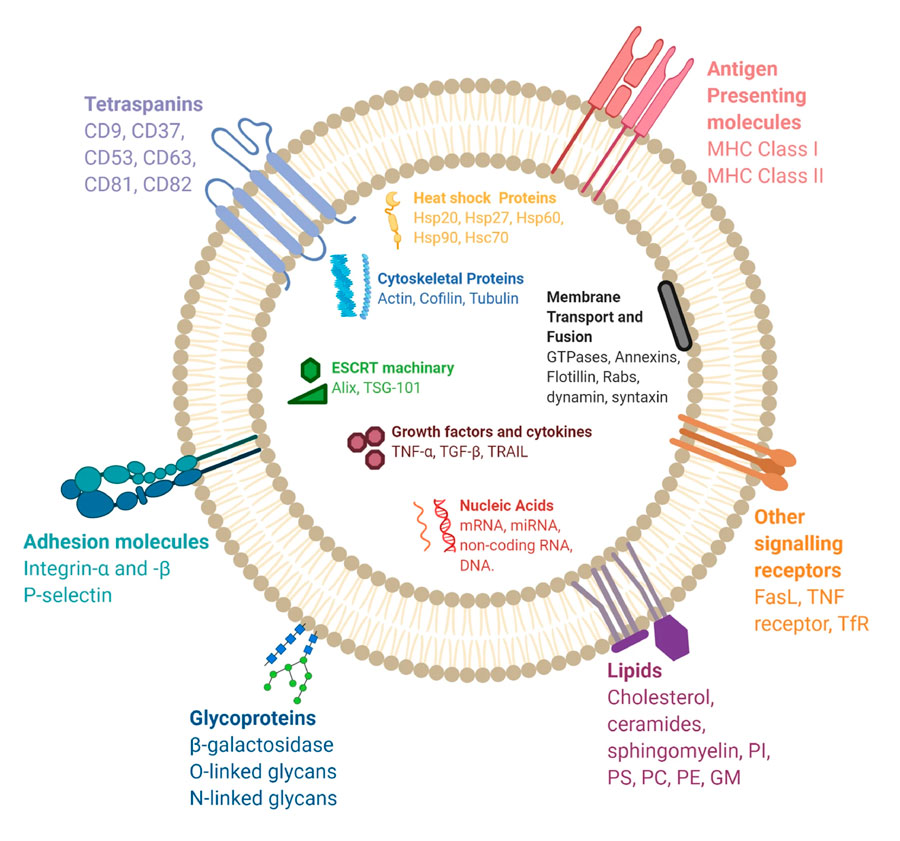The 5-star treatment everyone is talking about
What are exosomes?
Small, vesicle-shaped structures consisting of a lipid bilayer (between 40 and 160 nm) which form inside cells. They include different biomolecules, such as DNA, RNA, proteins, carbohydrates, and lipids.
Its function is the transport of materials and intercellular communication, modulating cellular processes (proliferation, cell differentiation, apoptosis, etc.).

(*) Gurung S et al., The exosome journey: from biogenesis to uptake and intracellular signalling. Cell Commun Signal. 2021 Apr 23;19(1):47.
HISTORY OF EXOSOMES
The term "exosome" comes from the Greek "exo," meaning "out of," and "soma," meaning "body.“
1980 - First discovered in the 1980s in blood cell studies. Initially, they were considered as "waste vesicles" produced by cells to remove unwanted components. The term “exosome” is coined.
1990 - In 1990, as research progressed, they were found to play an important role in intercellular communication and to contain proteins, nucleic acids, and lipids, and to transmit information between cells.
2000 - In the early 2000s, they began to be studied in the context of various diseases, including cancer, neurodegenerative diseases, cardiovascular diseases, and infectious diseases. It was found that exosomes could carry specific biomarkers of diseases and play a role in their diagnosis, progression, and treatment.
2015 - With the rise of regenerative medicine since 2015, its ability to promote tissue regeneration has been researched.
2023 - Currently, exosomes continue to be the subject of intense research in medicine. Clinical trials and therapeutic applications are being developed in the field of aesthetic medicine, dermatology, and trichology.
¿CÓMO SE FORMAN Y QUÉ FUNCIONES TIENEN?
La célula introduce biomoléculas y otros compuestos en el interior de vesículas, que luego se expulsarán al medio celular exterior en forma de EXOSOMAS.
Actúan como transmisores intercelulares entre las células vecinas y como moduladores de procesos celulares esenciales, como la proliferación, la diferenciación migración y la muerte celular.
TYPES OF EXOSOMES AND SOURCES
Natural exosomes
HUMAN
Generally used in research and medicine: placenta, umbilical cord, amniotic fluid, mesenchymal cells, etc.
ANIMAL
With cosmetic grade: colostrum
VEGETABLE
Extracts from: Damask rose, Gingko biloba, Centella asiatica, Leontopodium, gingseng, and sage.
BACTERIAL
Harmless microorganisms such as Lactobacillus.
Synthetic exosomes
MODIFIED
It consists of the insertion into donor cells of the gene encoding the target proteins for their manufacture and secretion into exosomes.
EXOSOMES vs LIPOSOMES
EXOSOMES
COMPOSITION
They can contain a variety of biomolecules: DNA, RN, lipids, proteins, and other compounds.
ORIGIN
Biological. They occur naturally inside cells and are released to the outside.
FUNCTIONS
Intercellular communication and participation in functional regulation processes.
LIPOSOMES
COMPOSITION
Synthetic lipid vesicles that can encapsulate water-soluble and fat-soluble compounds within them.
ORIGIN
Artificial. They are manufactured in laboratories.
FUNCTIONS
They work as a vehicle to deliver active ingredients or compounds in a targeted and controlled manner.
 Cookie preferences
Cookie preferences

